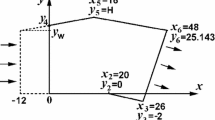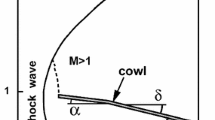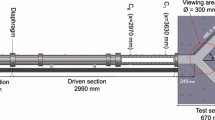Abstract
This work addresses two- and three-dimensional turbulent flow in simple channels, modeling the air intakes of rectangular cross section. Flow regimes with a supersonic free stream and supersonic velocities at the throat or immediately downstream of the throat are considered. Bifurcations of the shock wave arising ahead of the cowl are studied numerically. Solutions of the Reynolds-averaged Navier–Stokes equations are obtained with a finite-volume solver of second-order accuracy on fine computational meshes. The solutions reveal jumps of the shock leg position with variations of the free-stream Mach number. The dependence of the shock position on the cowl slope and streamwise location of the throat is examined.









Similar content being viewed by others
References
Sforza, P.M.: Theory of Aerospace Propulsion. Academic Press, Waltham (2012)
Daneshyar, H.: One-Dimensional Compressible Flow: Thermodynamics and Fluid Mechanics Series. Pergamon, Oxford (1976)
Maruyama, D., Kusunose, K., Matsushima, K.: Aerodynamic characteristics of a two-dimensional supersonic biplane, covering its take-off to cruise conditions. Shock Waves 18(6), 437–450 (2009)
Yamashita, H., Kuratani, N., Yonezawa, M., Ogawa, T., Nagai, H., Asai, K., Obayashi, S.: Wind tunnel testing on start/unstart characteristics of finite supersonic biplane wing. Int. J. Aerosp. Eng. Article ID 231434, 10 (2013)
Zha, G.-Ch., Knight, D., Smith, D., Haas, M.: Numerical simulation of HSCT inlet operability with angle of attack. AIAA Paper 97–2761 (1997)
Zha, G.-Ch., Knight, D., Smith, D.: Numerical investigations of HSCT inlet unstart transient at angle of attack. AIAA Paper 98–3583 (1998)
Oswatitsch, K.: Der Drukruckgewinn bei Geschossen mit Ruckstorsanttrib bei holen Uberschallgeschwindigkeiten. Goettingen Paper (1944). English translation: pressure recovery for missiles with reaction propulsion at high supersonic speeds. NACA TM 1140 (1947). http://link.springer.com/chapter/10.1007/978-3-322-91082-0_18. Accessed 10 Feb 2016
Ferri, A., Nucci, L.M.: The origin of aerodynamic instability of supersonic inlet at subcritical condition. NACA RM L50K30 (1951)
Dailey, C.L.: Supersonic diffuser instability. J. Aeronaut. Sci. 22(11), 733–749 (1955)
Trapier, S., Deck, S., Duveau, P.: Delayed detached-eddy simulation of supersonic inlet buzz. In: 2nd Symposium on Hybrid RANS/LES Methods, Greece, TP 2007-108, pp. 1–16 (2007)
Tanaka, N., Mizukaki, T.: Visualization of unsteady behavior of shock waves around supersonic intake installed in shock tunnel. In: 28th International Congress of the Aeronautical Sciences, pp. 1–7 (2012)
Soltani, M.R., Farahani, M.: Effect of angle of attack on the inlet buzz. J. Propuls. Power 28, 747–757 (2012)
Vivek, P., Mittal, S.: Buzz instability in a mixed-compression air intake. J. Propuls. Power 25, 819–822 (2012)
Nakayama, T., Sato, T., Akatsuka, M., Hashimoto, A., Kojima, T., Taguchi, H.: Investigation on shock oscillation phenomenon in a supersonic air inlet. AIAA Paper 2011–3094 (2011)
Hong, W., Kim, C.: Computational study on hysteretic inlet buzz characteristics under varying mass flow conditions. AIAA J. 52, 1357–1373 (2014)
Chang, J., Wang, L., Bao, W., Qin, J., Niu, J., Xue, W.: Novel oscillatory patterns of hypersonic inlet buzz. J. Propuls. Power 28, 1214–1221 (2012)
Kuzmin, A.: Shock wave instability in a channel with an expansion corner. Int. J. Appl. Mech. 7(2), 1550019-1–1550019-9 (2015)
Kuzmin, A.: Aerodynamic surfaces admitting jumps of the lift coefficient in transonic flight. In: Hafez, M.M., Oshima, K., Kwak, D. (eds.) Computational Fluid Dynamics Review 2010, pp. 543–562. World Scientific Publishing, Singapore (2010)
Kuzmin, A.: Non-unique transonic flows over airfoils. Comput. Fluids 63, 1–8 (2012)
Kuzmin, A.: Instability of the shock wave/sonic line interaction. E-print, Centre pour la Communication Scientifique Directe, Centre National de la Recherche Scientifique, France, pp. 1–11 (2015). https://hal.archives-ouvertes.fr/hal-01136894
Kuzmin, A.: On the lambda-shock formation on ONERA M6 wing. Int. J. Appl. Eng. Res. 9, 7029–7038 (2014)
Menter, F.R.: Review of the shear-stress transport turbulence model experience from an industrial perspective. Int. J. Comput. Fluid Dyn. 23, 305–316 (2009)
Sung, H.-G., Kim, S.-J., Yeom, H.-W., Heo, J.-Y.: On the assessment of compressibility effects of two-equation turbulence models for supersonic transition flow with flow separation. Int. J. Aeronaut. Space Sci. 14, 387–397 (2013)
Filonovich, M.S., Leal, J.B., Rojas-Solórzano, L.R.: Prediction of compound channel secondary flows using anisotropic turbulence models. In: Schleiss, A.J., de Cesare, G., Franca, M.J., Pfister, M. (eds.) River Flow 2014. Taylor & Fransis DGroup, London (2014). ISBN: 978-1-138-02674-2,163-170
Da Silva, B.R.G., Guerra, D.R.S., Silva Freire, A.P.: On the numerical calculation of impinging jets. In: Proceedings of 18th International Congress of Mechanical Engineering (COBEM’05), Ouro Preto (2005). http://www.worldcat.org/title/proceedings-of-the-cobem-2005-18th-international-congress-of-mechanical-engineering/oclc/500376152
Acknowledgments
This research was performed using computational resources provided by the Computational Center of St. Petersburg State University. The work was supported by the Russian Foundation for Basic Research under Grant No. 13-08-00288.
Author information
Authors and Affiliations
Corresponding author
Additional information
Communicated by F. Lu and A. Higgins.
Rights and permissions
About this article
Cite this article
Kuzmin, A. Shock wave bifurcation in convergent–divergent channels of rectangular cross section. Shock Waves 26, 741–747 (2016). https://doi.org/10.1007/s00193-016-0624-5
Received:
Revised:
Accepted:
Published:
Issue Date:
DOI: https://doi.org/10.1007/s00193-016-0624-5




